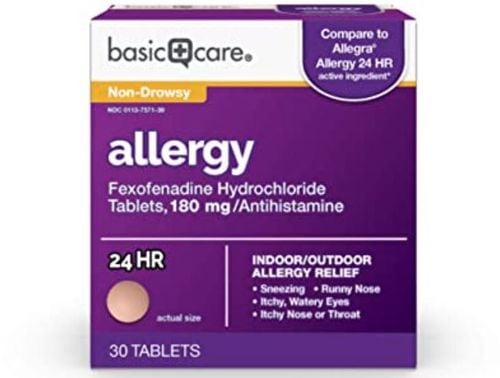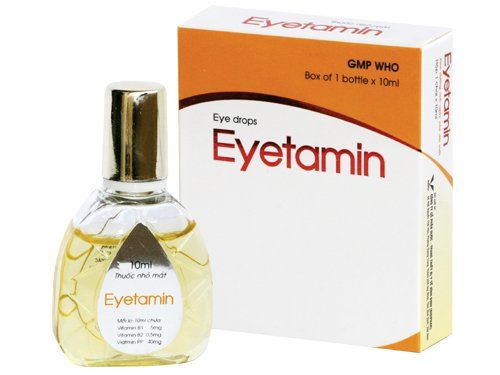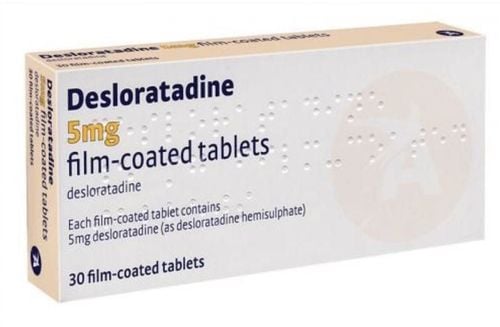This is an automatically translated article.
Takiqui is often recommended by doctors to quickly and effectively treat eye conditions such as edema, conjunctival congestion, lacrimation... For Takiqui eye drops to promote optimal use treatment, you need to follow the doctor's instructions.
1. What is Takiqui?
Takiqui belongs to the group of ear - nose - throat drugs, used mainly in the treatment of conjunctival edema and congestion. Takiqui is a product of Farmak JSC - U CRAI NA, prepared in the form of a sterile eye drop solution, each bottle has a content of 10ml.Each vial of Takiqui eye drops contains the following specific active ingredients:
Main active ingredient: Tetryzoline hydrochloride 0.5mg. Other excipients are sufficient: Boric acid, Benzalkonium chloride, Sodium chloride, Sodium tetraborate, Disodium edetate and water for injection.
2. What are the effects of Takiqui?
2.1. Uses of the drug Takiqui Active ingredient Tetryzoline hydrochloride in Takiqui is a sympathomimetic stimulant, when used through eye drops has the ability to reduce allergies and effectively fight edema. In addition, this active ingredient also works by stimulating Alpha adrenergic receptors of the sympathetic nervous system, thereby providing the benefit of reducing tissue edema, vasoconstriction, itching, pain and tearing.
After about a few minutes of eye drops, Tetryzoline hydrochloride will cause vasoconstriction and this effect lasts up to 4 hours. When administered at therapeutic doses, Tetryzoline hydrochloride has only local effects and is unlikely to be absorbed into the body.
2.2. Indications to use Takiqui drug Takiqui is usually prescribed by doctors to treat the following conditions:
Itching, irritation, edema or conjunctival congestion. Burning or tearing caused by physical and chemical factors, such as smoke, cosmetics, dust, exposure to strong light, swimming in chlorinated water, or wearing glasses pressure. Hemorrhagic/unspecific conjunctivitis. 2.3. Contraindications to the use of Takiqui Avoid self-administration of Takiqui in the following cases without consulting your doctor:
Patients with allergies or a history of hypersensitivity to the active ingredient Tetryzoline hydrochloride or any of its ingredients. excipients in the drug. Takiqui is contraindicated in children < 2 years old. Takiqui should not be used in patients with corneal endothelial dystrophy or glaucoma.
3. Dosage and how to use Takiqui effectively
3.1. You can refer to the dose of Takiqui to treat edema, conjunctival congestion and other eye problems with Takiqui according to the general recommendations below:
Dosage for children aged 2 - 6 age: Takiqui should only be used for this subject when prescribed by a doctor. In the absence of specific dosing instructions for Takiqui eye drops, pediatric patients can receive the usual dose of one drop in each eye once a day. Dose for children > 6 years old and adults: Instill 1-2 drops in each eye × 2-3 times/day. Avoid using Takiqui for more than 3 days in a row. If after taking the drug after 48 hours, the symptoms such as congestion, burning pain or watery eyes, etc. do not show any signs of improvement, the patient should stop taking the drug and notify the doctor or re-examine for treatment measures. more suitable treatment.
3.2. Instructions for safe and effective use of Takiqui The drug Takiqui is only for use by eye drops, so you need to avoid instilling in other parts of your body and avoid taking it by mouth. In addition, before treating eye problems with Takiqui, patients should carefully read the leaflet that comes with the bottle and follow the advice and treatment plan recommended by the doctor.
3.3. How to deal with an overdose of Takiqui eye drops Long-term treatment of Takiqui with high doses can lead to overdose causing toxicity. Some symptoms of Takiqui overdose include abnormal blood pressure, irritability, arrhythmias, or changes in body temperature.
For children, an overdose of Takiqui eye drops (especially in case of accidental ingestion) may cause symptoms such as hypotonia and drowsiness.
To manage Takiqui overdose, patients should stop taking the drug and seek supportive symptomatic measures as directed by the doctor.
4. What side effects does Takiqui cause?
Although Takiqui does not cause systemic side effects, in some cases, patients are at risk of experiencing the following adverse symptoms:
Headache. Pupil dilation. Increased intraocular pressure. Nausea, vomiting. Hypertension. Hypersensitivity reactions to the ingredients in the drug. Increased blood sugar. Cardiovascular disorders. Drug intolerance. If you experience any of the above, it is best to stop treatment and contact your doctor to find a way to fix it.
5. Things to keep in mind to ensure safety when taking Takiqui
During the treatment of eye problems such as edema, irritation, hemorrhagic conjunctivitis, ... with Takiqui, you should refer to some of the tips below to ensure safety and quick results. Result:
Patients with hyperthyroidism, hypertension, diabetes, taking monoamino-oxidase inhibitors (eg, Pargyline, Phenelzine, Tranylcypromine) or cardiac arrhythmias should use caution when using Takiqui. Before using Takiqui eye drops, patients should remove contact lenses because the active ingredient in the drug can affect the transparency of the lenses. After taking the medicine, you should wait about 5 minutes before putting your contact lenses back in. Currently, studies on the safety and effectiveness of Takiqui in pregnant or breastfeeding women are still limited. Therefore, these patients should only use Takiqui when absolutely necessary and must ensure strict compliance with the doctor's instructions. In rare cases, after instilling Takiqui, patients may experience blurred vision and dilated pupils. These phenomena have a significant effect on the patient's ability to drive and use machines, and therefore should be used with caution if these tasks must be performed frequently. Store Takiqui in a cool, dry place, away from light and at a temperature below 30 degrees Celsius. Check the expiration date of Takiqui on the package. This medicine has a shelf life of 2 years from the date of manufacture. In case it has expired, you need to stop treatment and remove the drug to avoid harmful effects.
6. Takiqui drug has the risk of interacting with any other drugs?
In fact, you can use Takiqui in combination with other eye drops on the advice of your doctor, but it is necessary to use at least 15 minutes between medicines to ensure that there is no interaction. work. In addition, avoid concomitant use with preparations that are incompatible with Monoamino oxidase inhibitors.
The article has provided information about uses, dosages and notes when using Takiqui. To ensure safety for your health and maximize the effectiveness of your treatment, you need to take Takiqui exactly as directed by your doctor, do not increase or decrease your dose or give prescriptions to others for use.
Please dial HOTLINE for more information or register for an appointment HERE. Download MyVinmec app to make appointments faster and to manage your bookings easily.













